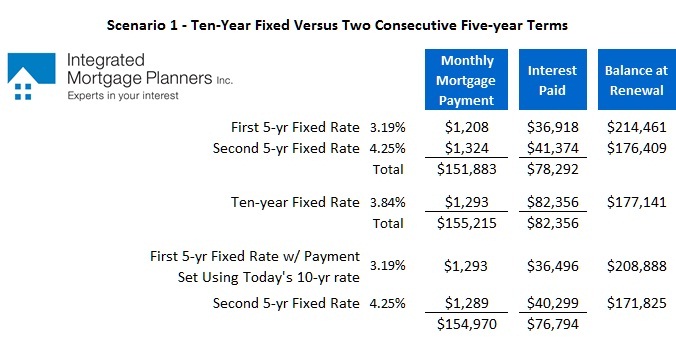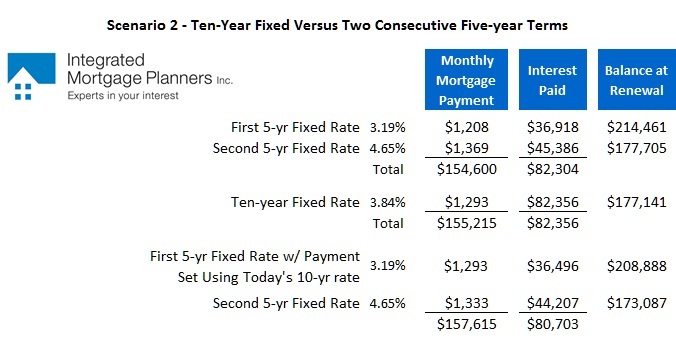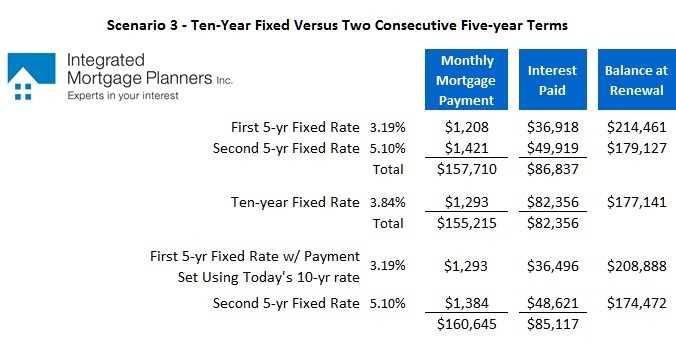What the Euro-Zone’s Long-Term Refinancing Operation (LTRO) Means for Canadian Mortgage Rates
March 5, 2012What the Latest Employment Reports Mean for Canadian Mortgage Rates
March 12, 2012It’s time for another rate simulation but this time we’re going to change it up.
The age old fixed-versus-variable question is off the front burner now that five-year fixed rates are available for only .5% more than five-year variable rates. When the spread between fixed and variable rates is that narrow, most borrowers just don’t think the variable rate offers enough of a margin of safety. Under today’s market conditions, I would agree.
Instead, the question most people are toying with these days is this: Does it make sense to lock into a ten-year fixed-rate mortgage instead of opting for the standard five-year fixed? When you consider that the market five-year fixed rate has averaged about 5% over the last decade, ten-year money at less than 4% starts to look very tempting.
To help you answer the five year/ten year question, today’s post will run three different scenarios to forecast where five-year fixed rates might be in five years (when today’s five-year fixed-rate would be coming up for renewal). Instead of explaining my view on where mortgage rates are headed, today’s post will show you when locking in for two consecutive five-year fixed-rate terms is cheaper, when the five year/ten year choice breaks even, and when choosing a ten-year fixed rate will leave you better off. You can decide for yourself which of these scenarios seems most likely.
Here are some basic points to review before we get started:
- The simulations will assume that you have a mortgage of $250,000, amortized over twenty-five years. We will compare the cost of a ten-year fixed-rate mortgage at 3.84% to the cost of a five-year fixed-rate mortgage at 3.19% that is renewed into a second five-year fixed-rate term at three different interest rates.
- Since I am a big fan of prepayment, we will add an additional wrinkle. In each scenario I will show you what happens to your overall interest cost if you take today’s five-year fixed rate (3.19%) but set your monthly payment using today’s ten-year fixed rate (3.84%). This assumes that you pay $1,293 each month, instead of the minimum payment of $1,208 that today’s 3.19% five-year rate would otherwise require. (You will see that paying this extra $85 each month has a surprising impact on your bottom line over time.)
Once we have compared the three different scenarios, I will close with some points about the ten-year fixed-rate mortgage – an often misunderstood product that is worth a long look from conservative borrowers who are willing to pay a small premium for a decades’ worth of interest-rate insurance.
Simulation #1
In this simulation we assume that at the end of the first five-year term, you are able to renew into a second five-year term at 4.25%.
In this scenario, choosing the two consecutive five-year fixed-rate terms (3.19% today and 4.25% at renewal) will save you a significant amount of money. The total of your monthly payments will be $3,331 lower and your outstanding balance at the end of this ten-year period will be $732 lower than if you had opted for the ten-year period instead. In total, choosing two consecutive five-year terms will have yielded you a net savings of $4,064 over the next decade.
Notice that the borrower who took today’s five-year fixed rate at 3.19% but then chose to set her monthly payment using today’s ten-year rate ended up with a total savings of $5,561. While she only saved $245 on her monthly payments over the entire period (because she ploughed her interest-rate savings back into her mortgage), her outstanding balance at the end of ten years is substantially lower. That lower balance will continue to reduce her future interest cost by thousands of dollars over the remaining fifteen years of her loan.
Simulation #2
In simulation #2 we assume that at the end of the first five-year term, you are able to renew into a second five-year term at 4.65%.
In this scenario, the difference between two consecutive five-year fixed-rate terms (3.19% today and 4.65% at renewal) and today’s ten-year fixed rate is negligible. The ten-year fixed rate will require a little more in monthly mortgage payments ($615), but that is almost entirely offset by the ten-year’s lower balance at renewal ($564). The net difference between the five and ten-year options is only $51.
That said, the borrower who took today’s five-year fixed rate at 3.19% and chose to set her monthly payment using today’s ten-year rate still ends up better off. While she makes an extra $2,400 in total mortgage payments, her balance is $4,054 lower at the end of ten years. On a net basis, her extra prepayments have given her a net savings of $1,653 when compared to a borrower who took the ten-year fixed rate and just paid the minimum. (Note: Our prepaying borrower breaks even with the ten-year rate when her second five-year fixed rate is at 4.82%.)
Simulation #3
In simulation #3 we assume that in five years’ time you renew into a second five-year term at 5.10%.
If this scenario unfolds, you will wish you had chosen the ten-year fixed rate at 3.84%. The ten year saves you $2,495 in mortgage payments and also finishes with a renewal balance that is $1,986 lower. In total, the ten-year fixed rate will save you $4,481 if your second five-year mortgage rate is 5.1%.
Meanwhile, our borrower who took the two five-year fixed-rate terms but set her initial five-year payment based on the ten-year repayment rate has not fared as poorly. While she made an extra $5,420 in mortgage payments, her balance at renewal is actually $2,669 lower than it would have been if she had initially taken today’s ten-year rate (again, because of the extra payments she made). On a net basis, she is only $2,761 worse off.
While I have seen a lot more interest from borrowers in the ten-year fixed-rate mortgage recently, most are still opting for a five-year fixed rate when push comes to shove. I can understand why. Choosing a ten-year option guarantees that you will be paying a higher interest rate for the first five years and you can’t be certain that you will recover that cost over the next five-year period. It’s only when you start to think of that additional rate premium as rate insurance that the decision becomes more palatable.
Here are three other important points about the ten-year fixed-rate option to factor into your decision:
- Buyers who are stretching their budgets to afford a home today are particularly vulnerable to higher rates five years hence. Locking in a ten-year rate immunizes this higher-risk group from interest-rate risk for a decade. (While choosing a ten-year fixed rate may well end up producing your lowest cost of interest, it is first and foremost a defensive move to protect against disaster.)
- If house prices are lower five years from now, highly leveraged borrowers could find themselves having to come up with extra money in order to renew their five-year mortgage. While it is rare for lenders to request appraisals from their renewing clients today, that could certainly change if house prices drop.
- It is true that breaking a ten-year fixed-rate mortgage in the first five years of your term would trigger a huge prepayment penalty, but lenders can only charge a penalty of three months’ interest after you pass your fifth anniversary date. Think of a ten-year fixed-rate mortgage as a five-year fixed-rate mortgage that comes with an option to keep your rate for up to five additional years, and if you choose not to fully exercise this option the cost is a three month interest penalty.
I think the most important question borrowers have to ask themselves these days is whether their first priority is paying the least amount of interest or protecting against their downside risk. If you are in a comfortable financial position and can overcome economic speed bumps like higher  inflation and interest rates, reduced income, job loss and/or a drop in house prices, then I think it’s a coin toss between whether the five-year or the ten-year fixed rate mortgage will end up saving you money over the next decade. If on the other hand you have a significant amount of leverage and are generally more vulnerable to economic setbacks, then the ten-year fixed rate will give you better protection. Not to mention a better night’s sleep.
inflation and interest rates, reduced income, job loss and/or a drop in house prices, then I think it’s a coin toss between whether the five-year or the ten-year fixed rate mortgage will end up saving you money over the next decade. If on the other hand you have a significant amount of leverage and are generally more vulnerable to economic setbacks, then the ten-year fixed rate will give you better protection. Not to mention a better night’s sleep.











4 Comments
True, but if you enter a closed mortgage, sell your house and want to get a new mortgage, then you have to pay the ridiculous penalty.
It is not always the three months interest, sometimes it is some differential between the posted rate and what rate you have, that worked out to about 11,000$ for our mortgage!!! That would have eaten through all the privilege payments we made.
I’d rather get a variable rate, open mortgage and lock in when it’s clear that the rates are going to go up. I’m sure there’s a figure somewhere where if you plotted variable rate vs fixed rate over the past 25 years, the variable rate was always the best idea. However, the past 25 years were special years… probably unlikely to repeat as a mortgage rate trend.
Also, there’s no guarantee that the economy and the interest rates are going to go up. Europe is in shambles, China is a bubble, the US is a mess, Canada is dependent upon all three of these variables. When I get a new mortgage, it’s going to be OPEN and VARIABLE. Never again will I get a FIXED CLOSED… god how much money I’ve wasted.
Hi Eric,
Thanks for your comment. To clarify, a lender can only charge you a penalty of three-months’ interest after the fifth anniversary date of your mortgage (by law). Before that it’s IRD and you’re right, that penatly would be a killer (as I mentioned in the post).
I agree that rates may not go anywhere fast, but I think five years down the road is long time and it’s really that time frame that matters in comparing today’s 5 and 10 year rates.
Re: open vs. closed mortgages. Open variable-rate mortgages are almost never the way to go. Unless you pay out the mortgage very early in your term you’re better to go with a closed variable and eat the three month interest-rate pently when you eventually break it. Here is a post I wrote on the topic if you are interested: http://www.integratedmortgageplanners.com/blog/mortgage-product-commentary/open-vs-closed-mortgages-the-surprising-winner-is%e2%80%a6/
The rates a out of date but the basic principles are the same.
Best regards,
Dave
If rates are going up, and with Fed tapering the QE, the long term mortgage rates rise, then the IRD penalty is negative, and the penalty reverts to the 3 months interest calculation even if you are in the first 5 years of a 10 year fixed mortgage.
Hi Colin,
When you break a ten-year mortgage, the IRD penalty is based on a comparison between the time remaining on your mortgage and the lender’s term that most closely matches that remaining time.
For example, if you have seven years left on your ten-year mortgage, then your ten-year contract rate will be compared to the lender’s current seven-year rate.
Since rates are typcially higher for longer terms, your ten-year rate would have to be lower than the lender’s current seven-year rate before a 3 months’ interest penalty would be greater than IRD, as you describe.
Also, since all of the major banks all use their posted rates to calculate their penalties, those lenders would use the ten-year posted rate that was offered when you got your original mortgage instead of the contract rate. This means that rates would have to be much, much higher still before a 3 months’ interest penatly would be greater than IRD.
Best,
Dave